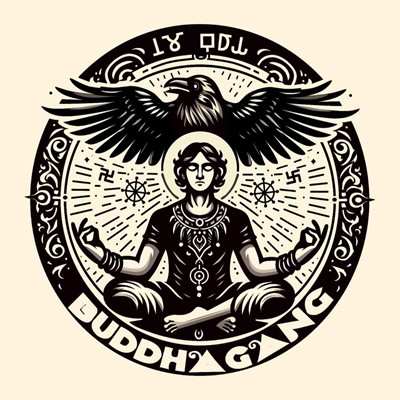Asanga Resources for Buddhagangsters who want to understand.
Links
🪬
http://lirs.ru/lib/Madhyantavibhanga,Maitreya,Thrangu,Levinson,2000.pdf
Madhyāntavibhāga by Maitreya with Commentary by Thrangu Rinpoche: This text explores the distinctions between the middle path and extreme views, emphasizing dependent origination as a bridge between ultimate and conventional truths. Thrangu Rinpoche’s commentary provides clarity on these concepts, resonating with BuddhaGang’s focus on understanding the nuances of reality
🪬
https://peachv.org/images/Dharmic/BudLogicMaitryaAsangaTucci.pdf
Buddhist Logic by Giuseppe Tucci: Tucci examines the logical frameworks developed by Maitreya and Asanga, shedding light on early Buddhist logic before Dignaga. This aligns with BuddhaGang’s emphasis on critical thinking and the application of logical analysis in understanding Buddhist teachings.
🪬
https://archive.org/details/MahayanaSamgrahaByAsangaTranslatedLamotteFrenchToEnglish
Mahāyānasaṃgraha by Asanga, Translated by Étienne Lamotte: This comprehensive work outlines the core tenets of Mahayana Buddhism, including the three natures and the path to enlightenment. Lamotte’s translation makes Asanga’s profound insights accessible, supporting BuddhaGang’s mission to disseminate foundational Mahayana teachings.
🪬
Yogācārabhūmi: Bodhisattvabhūmi Section, Śīla Chapter, Translated by Mark Tatz: This chapter delves into the ethical conduct required of bodhisattvas, discussing the essence and various aspects of ethics. It aligns with BuddhaGang’s commitment to ethical practice as a cornerstone of the path.
🪬
. “The Chapter on Right Conduct in the Bodhisattvabhūmi” by Michael Zimmermann: Zimmermann provides a detailed study of the Śīlapaṭala, focusing on the threefold division of ethics in Mahayana practice. This analysis supports BuddhaGang’s exploration of ethical conduct in the bodhisattva path.
🪬
The Realm of Awakening: A Translation and Study of the Tenth Chapter of Asanga’s Mahāyānasaṃgraha by Paul J. Griffiths and Noriaki Hakamaya: This work offers a translation and study of a pivotal chapter in Asanga’s text, discussing the stages of awakening. It provides valuable insights into the progressive path of realization, aligning with BuddhaGang’s focus on the stages of spiritual development.
How does this relate to Buddhagang?
It is clear that Prem’s teachings, heavily influenced by Asanga and other Mahayana luminaries, center around maintaining clarity in understanding reality. This involves avoiding extremes—weak nihilism or blind materialism—while staying deeply engaged in the world. Below are key elements and insights drawn from Prem’s teachings and approach:
1. Reality as Mind-Made but Meaningful
• Prem emphasizes that while reality is shaped by the mind (as in the Yogācāra or Vijnanavada view), it is “real enough to matter.” This echoes Asanga’s three patterns of reality:
• Imaginary Nature (Parikalpita): Our projections and delusions.
• Dependent Nature (Paratantra): The interdependent arising of phenomena.
• Perfected Nature (Parinishpanna): The ultimate understanding that these natures are inseparable and empty of inherent existence.
• Prem frequently stresses the importance of knowing the knowable—applying discernment to the dependent nature of things without clinging to illusions or falling into apathy.
2. The Middle Way: Neither Nihilism Nor Eternalism
• Prem’s teachings echo the Lankavatara Sutra and Mahamati’s insights, emphasizing that:
• Things and beings are neither inherently real nor non-existent.
• Understanding interdependence and emptiness doesn’t negate the importance of ethical action and engagement.
• For example, when discussing suffering, Prem points out that recognizing suffering’s constructed nature doesn’t free beings from the responsibility to alleviate it.
3. Critical Engagement with Skillful Thinking
• Prem consistently critiques “no-thinking-ism,” where people misinterpret teachings like “no thought” as an invitation to disengage or to avoid intellectual rigor.
• Instead, Prem advocates for skillful thinking—discerning and compassionate analysis of reality, as Mahamati does in the Lankavatara Sutra.
• This aligns with Asanga’s emphasis on cultivating discernment (prajna) and ethical effort (virya) to refine one’s understanding and action.
4. History and Conventional Reality Matter
• Prem frequently reiterates that history is real enough to matter. This insight aligns with Asanga’s recognition of the dependent nature: while it’s not ultimately real, conventional reality offers a framework for understanding karma, causality, and ethics.
• For instance, Prem’s critique of oppressive systems—patriarchy, oligarchy, or spiritual bypassing—reflects the belief that addressing these causes of suffering is both meaningful and urgent.
5. Skillful Means (Upaya) and Adaptive Eloquence
• Asanga’s emphasis on skillful means mirrors Prem’s approach in the BuddhaGang, where he:
• Uses memes, storytelling, and pointed critique to engage beings.
• Tailors his language to his audience, emphasizing clarity while refusing to dilute the Dharma.
• This reflects the bodhisattva’s task of making teachings accessible while preserving their depth.
6. Faith in the Dharma and the Role of Insight
• Prem highlights that Buddhist faith is not blind but rooted in confidence in the knowable aspects of the Dharma, which can be verified through direct experience.
• His teaching about faith as a bridge resonates with Asanga’s focus on guiding beings from conventional understanding toward ultimate realization through stages of faith and wisdom.
7. Responsibility and Action
• The BuddhaGang, under Prem’s guidance, emphasizes that understanding reality’s emptiness doesn’t excuse inaction. This reflects Asanga’s teaching that realization entails ethical responsibility.
• Prem rejects spiritual bypassing that leads to apathy, encouraging beings to confront suffering with fierce compassion and engage with systemic causes like greed, hatred, and delusion.
Summary: A Clear but Engaged Vision
Prem’s BuddhaGang teachings hold a unique space between academic precision and heartfelt compassion. They reflect Asanga’s nuanced understanding of reality while making it practical and relatable. By keeping things “seriously playful” and insisting on the Middle Way, Prem:
• Uplifts beings by helping them understand their suffering.
• Challenges distortions of the Dharma.
• Encourages active engagement with the world’s realities, balancing wisdom and love.
Prem’s approach is deeply Mahayana: uncompromising in its aim to benefit all beings and rooted in an understanding of interdependence and skillful action. It reflects Asanga’s vision of a bodhisattva path fully committed to both clarity and engagement. Let me know if you’d like to focus more deeply on specific points or teachings!


